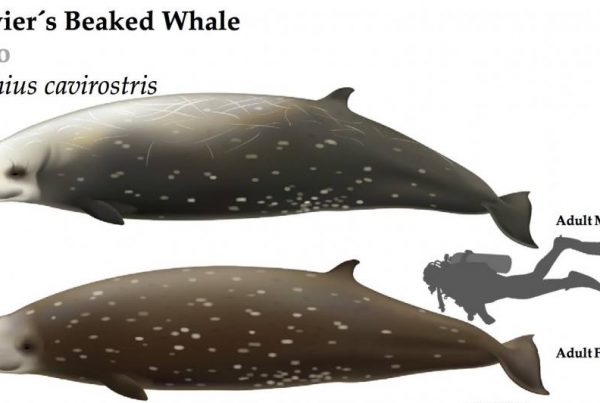
True’s Beaked Whales, Mesoplodon mirus, are named from Frederick W. True, a curator at the Smithsonian Institution (the World’s largest museum and research complex situated in Washington D.C.), who first described the species from an animal that stranded on a beach in North Carolina, USA.

True’s Beaked Whale sighted in Azores. Source: PeerJ.
CHARACTERISTICS
- Latin name : Mesoplodon mirus
- Suborder : Odotonceti
- Family: Ziphiidae
- Length : up to 6 meters
- Weight : up to 1.4 tons
- Dive time : up to 60 minutes
- Dive depth: up to 1000 meters
- IUCN Status: Data deficient

DESCRIPTION
Color: Dark to brownish grey on the back, lighter on the flanks and belly. The melon and head are typically lighter, and a dark patch appear around the eyes.
Head: Bulbous head with a short rostrum.
Fins: Small falcate dorsal fin at the two-thirds of the back.
Teeth: A pair of teeth on the tip of the lower jaw (mature male).

True’s Beaked Whale male with the teeth on the tip of the lower jaw visible, as well as a scar on the back probably caused by a sparring event with another male. Source: NOAA.
LIFE HISTORY
DIET
True’s Beaked Whales mainly feed on different species of squids. The occasionally eat fish and crustaceans. Prey is captured by suction feeding.
REPRODUCTION
Sexual maturity is reached at the length of 5 meters. At birth, calves measure around 2.5 meters in length. Very little is known about their True’s Beaked Whale reproduction.

SOCIAL BEHAVIOR
Often seen in small group of 3-4 individuals or by pairs. From scarring visible on the skin, it seems that there is sparring interaction between mature males most likely related to mating competition.

VOCAL BEHAVIOR
Little is known about True’s Beaked Whale vocalizations, they are probably also use echolocation to detect the prey. As other species of Mesoplodon genus, True’s Beaked Whales are unobtrusive when emerging and probably use acoustic crypsis to avoid detection by predators.







